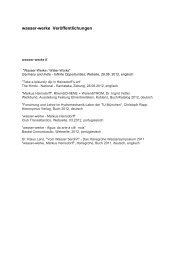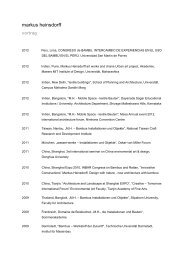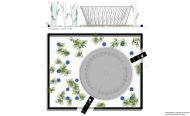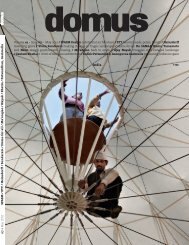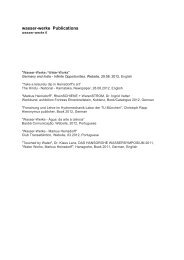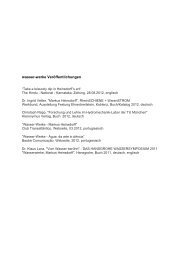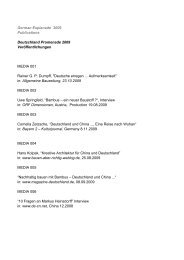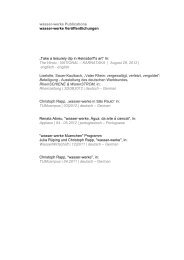Detail Magazin | Serie 2013 1/2 Transparent und - Heinsdorff, Markus
Detail Magazin | Serie 2013 1/2 Transparent und - Heinsdorff, Markus
Detail Magazin | Serie 2013 1/2 Transparent und - Heinsdorff, Markus
Sie wollen auch ein ePaper? Erhöhen Sie die Reichweite Ihrer Titel.
YUMPU macht aus Druck-PDFs automatisch weboptimierte ePaper, die Google liebt.
10 Leuchtende Edelsteine für Indien – ein Interview mit <strong>Markus</strong> <strong>Heinsdorff</strong> <strong>2013</strong> ¥ 1/2 ∂<br />
8 a b c<br />
“The Year of Germany in India” is winding<br />
down. Among its features was the “Indo<br />
German Urban Mela”, a collection of 16 pavilions<br />
that spent ten days each at five of<br />
India’s largest cities. The festival’s theme is<br />
“StadtRäume – City Spaces”, and it has<br />
shown a light on the impact and challenges<br />
of rapid urbanisation in the cities of both<br />
countries. The pavilions were designed by<br />
Munichbased artist <strong>Markus</strong> <strong>Heinsdorff</strong> and<br />
function as exhibition and presentation<br />
spaces for conferences and cultural events.<br />
Their facades possess the crystalline forms<br />
of polished gems and celebrate fabric, one<br />
of India’s important traditions. Following<br />
stops in Mumbai, Bangalore, Chennai, and<br />
Delhi the pavilions are on display in Pune<br />
until January 20, <strong>2013</strong>. In the following interview<br />
<strong>Markus</strong> <strong>Heinsdorff</strong> explains his design<br />
concept and discusses the choice of materials<br />
and sustainability, as well as physical<br />
presence and translucency.<br />
<strong>Detail</strong>: Please tell us about your concept for<br />
the pavilions.<br />
<strong>Markus</strong> <strong>Heinsdorff</strong>: Following the design competition<br />
I was commissioned to develop my<br />
concept, which deals with a variety of different<br />
aspects. One important motif is fabric – woven<br />
textiles – because this has a long tradition<br />
in India, which, to this day, next to China,<br />
plays a leading role worldwide in developing<br />
and producing fabric. At the same time, I am<br />
fascinated by how the people of India use<br />
tents in all sorts of ceremonies – and particularly<br />
for weddings. But the surfaces of these<br />
presentday tents are usually flat and, therefore,<br />
monotonous. That is why I selected<br />
gems as the theme for my pavilions – a theme<br />
that is derived from the overarching motto:<br />
nature. This led to the multifaceted forms and<br />
also symbolises India’s rich heritage – its<br />
splendid costumes, colours, jewels, and<br />
above all, its haute couture. Sustainability also<br />
plays a leading role in my concept.<br />
How did you decide which colours to use?<br />
It quickly became clear that the colour<br />
scheme should be muted, because India itself<br />
is a riot of colour. I wanted to create something<br />
of a stage, a setting animated by the<br />
colour and actors inhabiting it. The pavilions’<br />
colours are related to the gems. I chose<br />
mostly metallic tones – gold, silver and copper<br />
– i.e. the material in which stones are set. We<br />
tested the effect in renderings at a quite early<br />
stage, and it is fascinating to see that the pavilions<br />
do now resemble precious stones.<br />
In your earlier work in China you used bamboo<br />
for structural purposes. Why did you<br />
choose steel here?<br />
First of all, there had to be a clear distinction<br />
between how the two countries present themselves.<br />
A central concept in India was to utilise<br />
the country's possibilities – so it would have<br />
8 Schnitte <strong>und</strong> Gr<strong>und</strong>risse Pavillons/Sections and<br />
floor plans of the pavilions<br />
a Typ 1/Type 1, b Typ 2/Type 2, c Typ 4/Type 4,<br />
d Typ 3/Type 3, e Typ 7/Type 7<br />
9 Typ 5 <strong>und</strong> 1 in Delhi/ Type 5 and Type 1 in Delhi<br />
been risky to use bamboo, because the firms<br />
no longer have experience with it. Using bamboo<br />
was difficult in China, but some technically<br />
savvy firms can be fo<strong>und</strong> that know how to<br />
work with it. Because we had a relatively brief<br />
amount of time – six months – to prepare the<br />
design for realisation, we resisted the temptation<br />
to try hightech solutions and instead developed<br />
– in cooperation with schlaich bergermann<br />
<strong>und</strong> partner – lightweight steel structures<br />
that can be implemented with simple<br />
means. In the end, we didn’t even have a bona<br />
fide steelwork contractor here; some of the<br />
work was done by unskilled workers or welders.<br />
As a result, some aspects of our planning<br />
could not be implemented. However, the<br />
steelwork turned out to be reasonably precise.<br />
By using steel – nothing more than cables and<br />
slender steel tubing – we were able to achieve<br />
incredibly lightweight yet expansive structures.<br />
Nearly all of the interiors are columnfree, a<br />
plus for flexible usage. And this was possible<br />
despite the fact that the structures were, in<br />
some cases, exposed to severe winds caused<br />
by tropical storms. For a few special surfaces<br />
– for example, by weaving cables in the roof of<br />
the large conference pavilion – we were also<br />
able to use steel to refer to our fabric theme.<br />
By the way, this roof brings to mind a wheel,<br />
the symbol that appears on the Indian flag.<br />
You mentioned that sustainability was an important<br />
theme. Could you elaborate?



